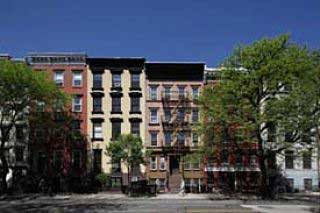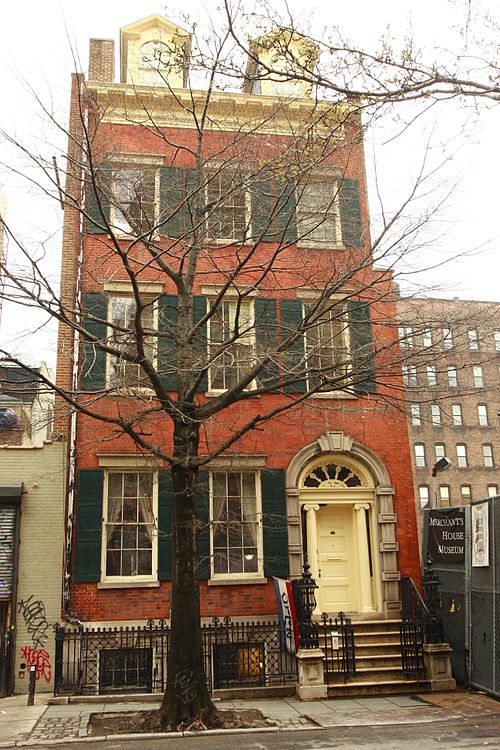Strong Support for Proposed East Village / Lower East Side Historic Districts Shown at CB3 Meeting
The NYC Landmarks Preservation Commission presented the East Village / Lower East Side and East 10th Street historic district study areas at a packed Community Board 3 Landmarks Subcommittee meeting May 12. LPC outlined the history, architecture and overriding historical theme of the districts, whose buildings still show the area’s transformation during the 19th and early 20th century from a neighborhood of merchant rowhouses to a thriving immigrant community.

Many audience members signed up to speak. LESPI’s Richard Moses emphasized that the historic districts are critical for preserving the area’s architecture and history and would be, to LESPI’s knowledge, the first districts to specifically celebrate immigration history. Most other community comments supported the LPC’s plans, and though some participants also expressed concern about potential costs for owners and impacts on affordable housing, the testimony showed a powerful consensus that the community wants landmark protection for the historic buildings in these districts.
LESPI Works to Expand Historic District Study Area Boundaries
LESPI joined with Greenwich Village Society for Historic Preservation, Historic Districts Council, and East Village Community Coalition to request that the Landmarks Preservation Commission expand its East 10th Street and East Village historic district study area boundaries to include additional contiguous historic buildings that further contribute to the districts. On May 18 we met with NYC Councilmember Rosie Mendez, LPC Chair Robert Tierney and Executive Director Kate Daly, along with GVSHP, HDC, and EVCC to advocate for this proposal.

The good news: after some further review, LPC has agreed to extend the East Village / LES district boundaries to include 2nd Street between First and Second Avenues, and the corner of East 6th Street and Avenue A up to the Pyramid Club building (which LESPI previously supported for Individual Landmark designation).
LPC has also agreed to future consideration of the east side of Avenue B around and to the south of East 10th Street.

Although LPC has stated that it does not want to include the other proposed additions, we believe that these two expansions were the strongest candidates. At this point we fully support LPC’s district boundaries, and are mindful that we do not want to significantly slow down LPC’s scheduling for the designation process: the timeline includes LPC calendaring the districts in June for a fall public hearing, and Community Board 3 holding its public hearing in July. LESPI now wants to do everything we can to help the districts move ahead “full steam” toward landmarking. And in the meantime, LESPI is not losing sight of the fact that additional historic districts on the Lower East Side will need to be designated to truly protect the historic areas of our invaluable and vital community.
Taking A Close Look At Our Historic Streets
One of our primary goals at LESPI is to understand exactly what historic architecture exists in the East Village / Lower East Side, and to determine where this architecture is still extant in highest concentration. Our Survey and Mapping Committee, headed by preservation architect and LESPI member Britton Baine, has been hard at work identifying the historic buildings of the Lower East Side, particularly where they exist in clusters, and is continuing to analyze data about LESPI’s current study area: the blocks surrounding and to the west of Tompkins Square Park. This task is central to LESPI’s mission of advocating NYC historic district designation for the Lower East Side’s intact historic streetscapes.
Before determining the Tompkins Square study area boundaries, LESPI members and volunteers surveyed every block of the East Village, and recorded each building’s apparent age, architectural characteristics and alterations on specially devised survey forms. The committee then gave each building a rating number based on a combination of its age and the intactness of its architectural features. Buildings got high ratings – ones and twos – when they showed clear historic value and retained most or essentially all of their historic features. Original cornices, ornament, window sills and lintels, stoops, doorways and storefronts all helped to boost a building’s rating. A group of highly-rated buildings on one or more blocks would be a clear place to investigate a potential historic district.

Buildings got middle-range ratings – threes and fours – when they related to the higher-rated buildings in some respects such as scale or materials but were neither historic or intact enough to carry a historic district on their own. Buildings rated at five, the lowest rating, were not considered contributors, and may even detract from a district.
So, what’s next? The committee is currently plotting its findings building-by-building on a map, translating the numbered ratings into color coded lots. As each block on the map is completed, the color coding quickly shows if a block is packed with important, well-preserved historic structures rated one and two, or with more neutral, not-so-historic, threes and fours.

Once mapping is complete – and the Tompkins Square study area nearly is – LESPI can weigh all the areas of the East Village / Lower East Side by historic architectural interest and importance, and we can then prioritize where to focus our advocacy for landmark protection.
Greek Revival Rowhouse Facades to be Spared?
When work began at the two ca. 1840 Greek Revival rowhouses at 326 and 328 East 4th Street over the winter, it looked like the contractors had blasted a hole the size of a tank through one of them. Everything behind the façades was rubble. The community was furious.
Robert Slaughter, a LESPI member who lives nearby and who has been monitoring the project, recently met with Chondary Ahmed, the project engineer, for an update. Mr. Ahmed asserted that the facades’ architectural elements have been saved on site and that every effort will be made to restore them. Before construction started, most of the buildings’ original features such as brickwork, ornate wood entry surrounds and hand wrought iron railings were intact.
These two buildings were once very close to the East River, before landfill pushed the water’s edge blocks away. The original inhabitants worked at the port where tall sailing ships docked and where billowing white sails could have been seen from the rooftops. Years passed and the port and the neighborhood were reincarnated many times. The most recent inhabitants, Richard and Dorothea Tyler, moved in in 1974 and created the Uranian Phalanstery, a meeting ground for artists. Unfortunately, recent economic issues forced the property’s sale.

Although LESPI believes that building renovations should preserve more than merely façade veneers, and that any rooftop additions must be scaled and placed so as not to interfere with the building’s architecture, we are glad that the developer for these irreplaceable historic buildings has proclaimed his intention to respect the area’s history and architecture by maintaining their beautiful facades. We’ll keep you posted as the project progresses.
35 Cooper Square: Gone But Not Forgotten
On May 25 LESPI joined a crowd of about 50 to mourn and, more importantly, to protest the demolition the federal style 35 Cooper Square. Originally built by the Stuyvesant family in 1825, this building later housed such cultural figures as poet Diana di Prima and actor Joel Gray. It was one of the most important historic structures anchoring the northern end of a Bowery National Register Historic District.

The rally, organized by Bowery Alliance of Neighbors, and sponsored by LESPI, Two Bridges, HDC, GVSHP. EVCC and several other preservation and community groups, showcased speakers including LESPI who called for landmarking and downzoning to protect the Bowery’s and the Lower East Side’s historic resources, and for using the demolition – which apparently had been completed that day – as a rallying cry to prevent further demolitions of our irreplaceable historic buildings and landmarks.
FILMMAKERS WANTED!
Filmmakers: are you looking for what may be the Volunteer Opportunity of a Lifetime…a chance to help make New York City history? LESPI is conducting an oral history of East Village cultural figures such as visual artists, musicians, writers, poets, photographers to illustrate how the East Village / Lower East Side – the people, streets, parks and buildings – encouraged the creation of their art.
We expect to work with several filmmakers on separate portions of the documentary. The film’s primary purpose is to document the area’s rich cultural history and to raise awareness of this creativity to help in the landmarking of historic districts in the area. The documentary’s audience will be the New York preservation community, those interested in EV/LES cultural figures, and anyone who loves NYC history, culture and architecture. It should also be great exposure for the filmmaker. If you are interested please contact us at info@LESPI-nyc.org.
Support LESPI!
We’re looking for people to help with outreach, people with specialized skills and experience, monetary donations (which are tax deductible as allowed by law), and any other assistance that can help further our mission. We’d very much appreciate your help in our campaign to preserve the East Village / Lower East Side and hope to hear from you in the near future.
Search “Lower East Side Preservation Initiative” on Facebook and check out our site! If you click the “Like” button you’ll receive periodic preservation, history and architectural updates for the LES/EV. You’ll also be showing support for our cause!
About LESPI
LESPI was formed in 2007 to urge the LPC to designate as historic districts intact portions of the East Village / Lower East Side. Our strategy includes documenting and mapping the historic streetscapes, starting with the East Village, and rallying community residents, city officials and the LPC to effect landmark designation.

Contact us by email at info@lespi-nyc.org or use the form, through our web site lespi-nyc.org, or by mail at LESPI, c/o Neighborhood Preservation Center, 232 East 11th Street, New York, NY 10003.



